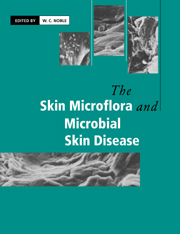Book contents
- Frontmatter
- Contents
- List of contributors
- Preface
- 1 The basis of the skin surface ecosystem
- 2 Nutrition of cutaneous resident microorganisms
- 3 Physical factors affecting the skin flora and skin disease
- 4 Coryneform bacteria
- 5 Coryneforms as pathogens
- 6 Staphylococci on the skin
- 7 Staphylococci as pathogens
- 8 Streptococci and the skin
- 9 Other cutaneous bacteria
- 10 Fungi and fungal infections of the skin
- 11 Bacterial and fungal skin disease in animals
- 12 Viral skin disease in man
- 13 Viral skin disease in animals
- 14 Microbial interactions on skin
- 15 Adherence of skin microorganisms and the development of skin flora from birth
- 16 Skin disinfection
- Index
11 - Bacterial and fungal skin disease in animals
Published online by Cambridge University Press: 04 December 2009
- Frontmatter
- Contents
- List of contributors
- Preface
- 1 The basis of the skin surface ecosystem
- 2 Nutrition of cutaneous resident microorganisms
- 3 Physical factors affecting the skin flora and skin disease
- 4 Coryneform bacteria
- 5 Coryneforms as pathogens
- 6 Staphylococci on the skin
- 7 Staphylococci as pathogens
- 8 Streptococci and the skin
- 9 Other cutaneous bacteria
- 10 Fungi and fungal infections of the skin
- 11 Bacterial and fungal skin disease in animals
- 12 Viral skin disease in man
- 13 Viral skin disease in animals
- 14 Microbial interactions on skin
- 15 Adherence of skin microorganisms and the development of skin flora from birth
- 16 Skin disinfection
- Index
Summary
Introduction
The range of bacterial and fungal skin disease in animals is very wide and involves many pathogens that also have significant systemic effects. Comprehensive consideration of all of these infections is beyond the scope of this review and attention will be concentrated on infections of terrestrial mammals and on diseases of the general body surface. Infections of specialized skin regions, such as the ear, vulva, prepuce and skin glands, will be considered more briefly and no attempt will be made to cover mastitis. Similarly, diseases in which the skin signs form a minor part will only be mentioned briefly. Zoonotic infection is not considered here.
The skin is an efficient defensive organ and the great majority of animals have a healthy looking skin and coat. Despite this, careful examination will usually reveal the presence of minor lesions and virulent pathogens can often be demonstrated on the skin in absence of any signs of disease. These will seldom lead to clinically significant infection but are an indication of the constant battle that goes on between skin immunity and external challenges, particularly those associated with microorganisms. In animals, as in man, clinical skin infection generally results only after the equilibrium between the skin, its normal flora and fauna, and the external environment has been disturbed (see other chapters in this book) or, less commonly, following access of pathogens to the skin via the systemic route. Thus very few microorganisms can be considered to be truly primary skin pathogens.
- Type
- Chapter
- Information
- The Skin Microflora and Microbial Skin Disease , pp. 264 - 290Publisher: Cambridge University PressPrint publication year: 1993
- 5
- Cited by



